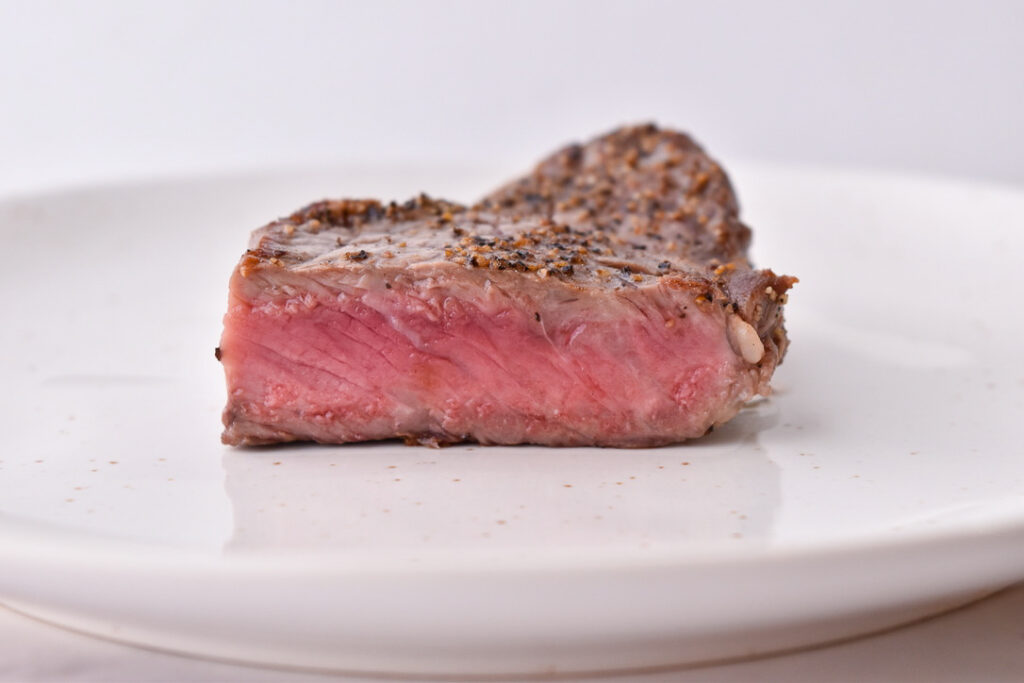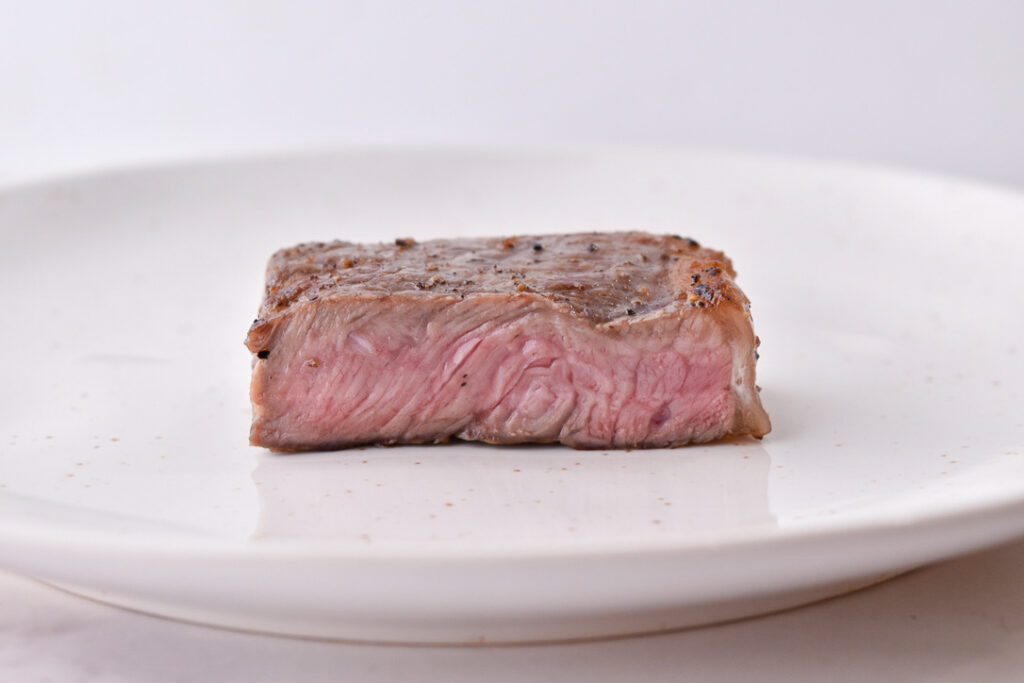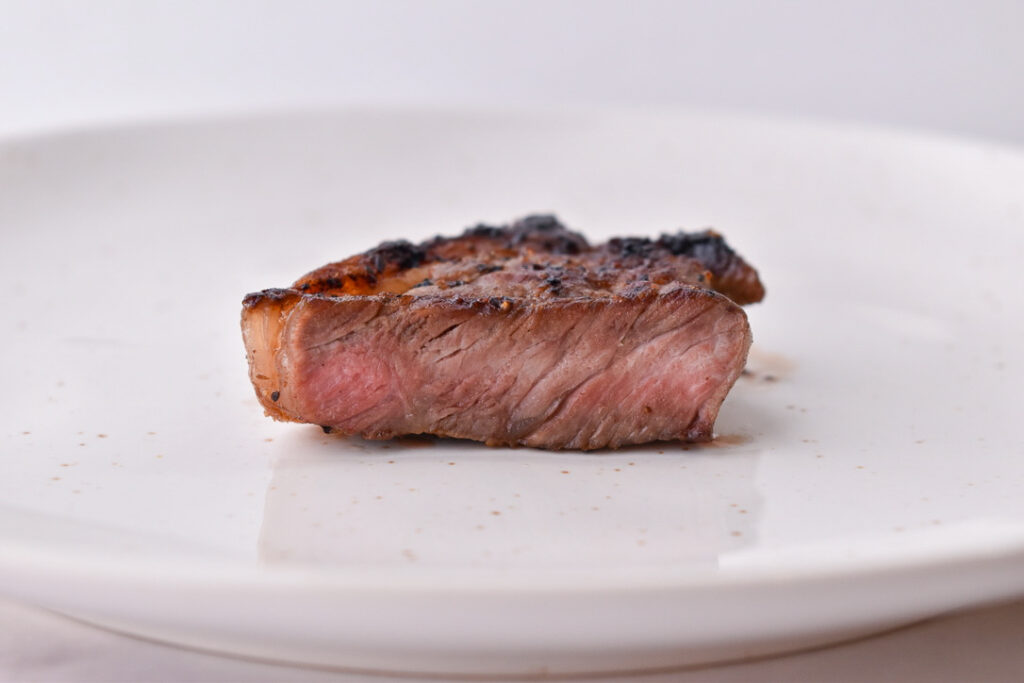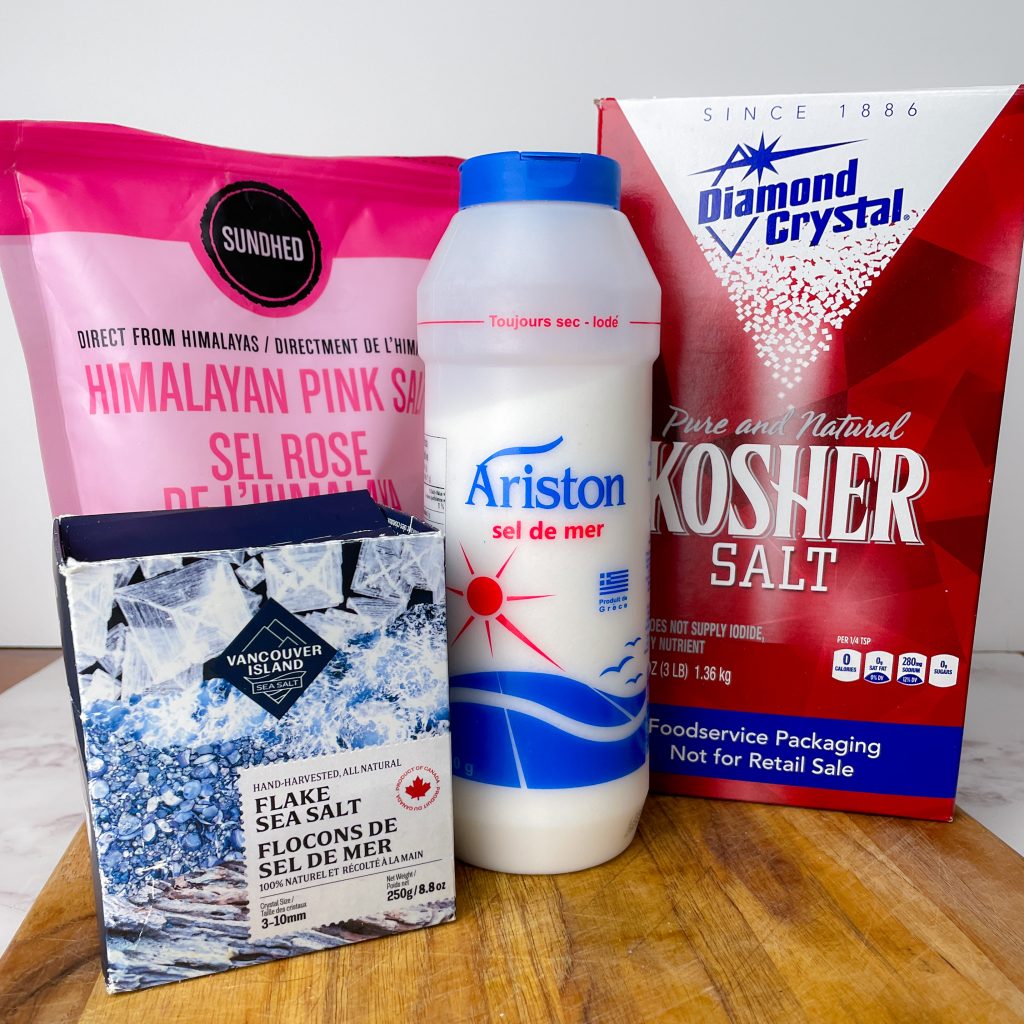Treat yourself to a succulent steak cooked precisely how you like it! We have all the knowledge and tools to achieve the perfect steak doneness; from steak doneness levels, temperature guides and charts, to touch tests and the best thermometers. Plus what to do if you’ve undercooked or over-cooked your steak!
Time to tantalize your taste buds with perfectly prepared steaks tonight!
Steak is a popular dishes for home cooks. But it can be tricky to get the doneness just right. Too rare, and you might have some complaints from your guests; too well-done and you’ll be left with a dry, flavourless steak.
What is the Perfect Doneness for Steak?
The perfect doneness for steak is subjective and based on individual preferences. Generally speaking, the perfect doneness for steak is achieved when the steak is juicy and moist while the exterior is perfectly browned and caramelized.
Many steak-lovers aim for a final temperature somewhere around 130ºF – 140ºF from a medium-rare to medum steak.
To achieve this, the steak is removed from the heat when it is 5-10ºF below the final desired temperature to rest (check it with this thermometer). During this resting period, the steak will continue to cook as residual heat continues to raise the internal temperature of the steak. This is why it’s important to remove the steak from the heat source when it is a few degrees lower than the desired doneness.
While our preference for steak is medium-rare, we can see that many Canadians and Americans prefer other levels of steak doneness.

What Are the Different Levels of Doneness for Steak?
No doubt you’ve heard the terms for doneness with regards to foods like steak before. When visiting fine dining establishments, the server will ask you how you’d like your steak cooked—rare, medium-rare, medium, medium-well, or well-done.
The terms “rare”, “medium rare”, “medium”, and so on, are not just descriptors of its colour! For instance, when someone orders their steak medium-well, it means more than simply having only a little pink in the middle; there’s much more to it!
To achieve the perfect steak doneness, it’s all about accurately gauging temperature rather than judging by looking at the steak. We discuss ways to accurately gauge steak doneness further on in this post!
Benefits of Steak at the Perfect Doneness
Knowing how to cook a steak to the perfect doneness is essential for a home cook. If done incorrectly, a juicy, flavorful steak can quickly become an unpleasant dried-out chunk of beef (even worse if it’s burnt!). But when you master this skill and find that sweet spot between rare and overdone, then meals at home will be just as delectable as those from your favourite restaurant!

Bet you haven’t tried them all!
Grab our Summer Steak Passport Challenge and see if you can taste each cut this summer!
Steak Doneness Temperatures
Here we’ve listed the different levels of steak doneness along with the final cooking temperature. Be sure to keep reading because the internal temperature when you remove the steaks from the heat is different from the final temperature.
Blue Rare 115ºF / 46ºC
Blue rare is similar to rare but the steak is cooked slightly less. The outside of the steak is quickly seared, leaving the inside red and cool inside.
Why is it called blue rare? There are various theories as to why it was named blue rare. Some believe that blue steak is named as such due to the hue’s association with “cold” and “cool,” signifying an interior temperature that should be achieved when cooking.
Another theory is the purplish colour of the steak interior may have been the inspiration for the name.
Blue rare steaks are prepared by doing a very quick sear on all sides of the steak (top, bottom, and sides) until a final internal temperature of 115ºF.
Is Blue Rare Steaks Safe to Eat?
There are a few factors to consider if you are thinking about consuming blue rare beef; from health official recommendations and the source of your beef, to how it was handled and how you prepare it. You can learn more in this post “Is it Safe to Eat Rare Steak“.

Rare 125ºF / 52ºC
“Rare” steak is not the same as “raw”. A raw steak is defined as one that is not cooked at all – it is fresh and pink or red on the exterior as well as the interior.
A rare steak is prepared and then seared or grilled, whereupon its outer layer will caramelize yet its center remains soft and red. The searing will cook a thin portion of the exterior layer of the steak leaving the center very red. Those that enjoy rare steak love the contrast of a crispy exterior to a slightly warm, tender interior of the steak.
If you enjoy your steak doneness as rare, it’s recommended to select steaks that will yield the best results. Since these steaks are cooked very quickly, fattier steaks won’t have time to render properly. That means you may want to steer clear of prime rib or ribeye steaks for this level of steak doneness.
Opt for leaner cuts of beef such as tenderloin steak or top sirloin steak.
To achieve a perfectly cooked rare steak, sear it at an intense temperature (400°F) for several minutes on each side. This will result in its vibrant red center that is soft to the touch and has very little resistance when pressed with your finger.

Medium-Rare 130ºF / 54ºC
Medium-rare is one of the most popular levels of steak doneness. We say one of them because we were surprised at the outcomes of certain studies detailing customers’ preferences for steak doneness (see above comparing Canadians and Americans preferences for steak doneness).
If you’re in search of the juiciest and most tender steak – medium-rare is where it’s at! At this temperature, steaks are heated through. When cut open, they will have an alluring deep pink hue in the middle that is slightly resistant when touched.
These steaks are cooked to a final internal temperature of 130ºF.

Medium 140ºF / 60ºC
A medium steak is also a popular choice with its lighter pink center and seared exterior. No visible dark red should be present in the middle of a medium steak. Pressing lightly with your finger should yield slight resistance.

Medium-Well 150ºF / 66ºC
Medium-well steak is cooked until a final temperature of 150ºF. Its appearance will have a trace amount of pink in the center with a larger brown exterior. You will find more resistance when you press this meat with your finger.

Well Done 160ºF / 71ºC
A well-done steak is cooked throughout, with no pink whatsoever visible in the center. Much of the fat will have been rendered, along with quite a bit of the juices. The final temperature would be 160ºF or more.
Steak Doneness Temperature Chart
The following chart provides the different doneness levels and the corresponding temperatures.

How to Tell Doneness Using a Thermometer
There is a reason you’ll find one (or several) thermometers in a chef’s kitchen or commercial kitchen. A thermometer is the only sure way to know when a steak reaches the desired level of doneness.
This is one of our favourite instant-read thermometers.
Insert it into the thickest part of the meat while avoiding any bone or gristle. Make sure the tip is centred and not pushed through to the bottom part of the meat. You want the tip positioned at the coldest part of the meat (which would be the thickest portion).
For thinner steaks, pierce the thermometer at an angle to ensure you reach the center.
With larger or thicker steaks, you’ll want to take a temperature reading at a couple of different locations (it’s normal for the temperature to vary).
Oh, and you’ll want to make sure your thermometer is calibrated (check the instruction guide of your thermometer)!
How to Tell Doneness by Touch
There is a technique (or several techniques) in which some like to touch the steak to check for resistance as a way to determine doneness.
While this method is convenient, it isn’t overly accurate so we can’t recommend it. This method is based on the resistance of the steak when you poke it with your finger. Each type of steak has its own natural resistance that can change as it cooks. So a striploin at medium-rare may not feel the same as a bavette steak at the same level of doneness.
Regardless, we’ll cover the method here in case you are stuck in a situation without your trusty meat thermometer.
There are various touch methods that we could cover. We’ll stick to the easiest method which is forming an “ok” sign with your hand by gently touching the tip of your thumb to pointer finger. Now feel the resistance in the pad at the base of your thumb. This is what a rare steak would feel like when poked with your finger.
Now, move along to touch the tip of your thumb to your middle finger. Touch the pad at the base of your thumb. This resistance would be equivalent to medium-rare.
Thumb to ring finger would be medium-well.
Thumb to pinky finger would be well done.
Carryover Cooking and Temperature
Did you know your steaks continue cooking after you’ve removed them from the heat? This is called carry-over cooking and you need to factor this into your meat temperature.
Once you remove the steaks from the grill or pan, they will continue to rise in temperature by 5-10ºF.
This means you should remove your steaks (and any meat for that matter), from the heat source when the internal temperature is 5-10ºF BELOW your final desired temperature.
For example, if you want medium-rare steaks at a temperature of 130ºF, you will need to remove them from the heat at a temperature of 120-125ºF.
Cooking Tips to Achieve the Perfect Doneness Every Time
Here are some tips to help you achieve the perfect doneness every time:
- opt for steaks that are the perfect thickness where possible
- start with your steaks at room temperature and remove them from the fridge 1 hour before cooking
- ensure your grill or pan is HOT, and allow enough time to preheat
- place the steaks on the grill or pan so that they receive an even heat distribution (don’t lay your steak halfway over indirect and direct heat)
- remove the steaks when they are 5-10ºF BELOW your desired doneness
- rest them on a plate or cutting board that is tented loosely with foil so that the juices can redistribute (don’t keep them in a hot pan or they will continue to cook)
- slice your steaks against the grain for the best tenderness
What to Do If You Overcook or Undercook the Steak
If you undercook a steak, place the steak back on a hot grill or in the oven on an oven-safe pan like cast iron. Watch it carefully, because you don’t want to go too far and overcook the steak! Depending on your grill or oven temperature, this could take seconds or minutes to bring it to your desired temperature.
Overcooked steak is a tough one (literally!). It will be dry and chewy.
If you’re having guests you may want to start over with fresh steaks or change your meal plans.
But if that’s not an option, there are a few things you can try:
1) Slice your steak thinly against the grain to improve the tenderness
2) Top your steaks with steak drippings, compound butter or chimichurri to bring some fat and flavour into the steak. You could also try steak sauce.
Now, take some time to refine your grilling abilities so that you can avoid similar mishaps in the future!
Get the Perfect Doneness Every Time!
Cooking the perfect steak is an art and a science. Now you have everything you need to know to get the best doneness for steak and achieve the perfect steak every time. With a little practice and these tips, you’ll be grilling perfect steaks in no time!









